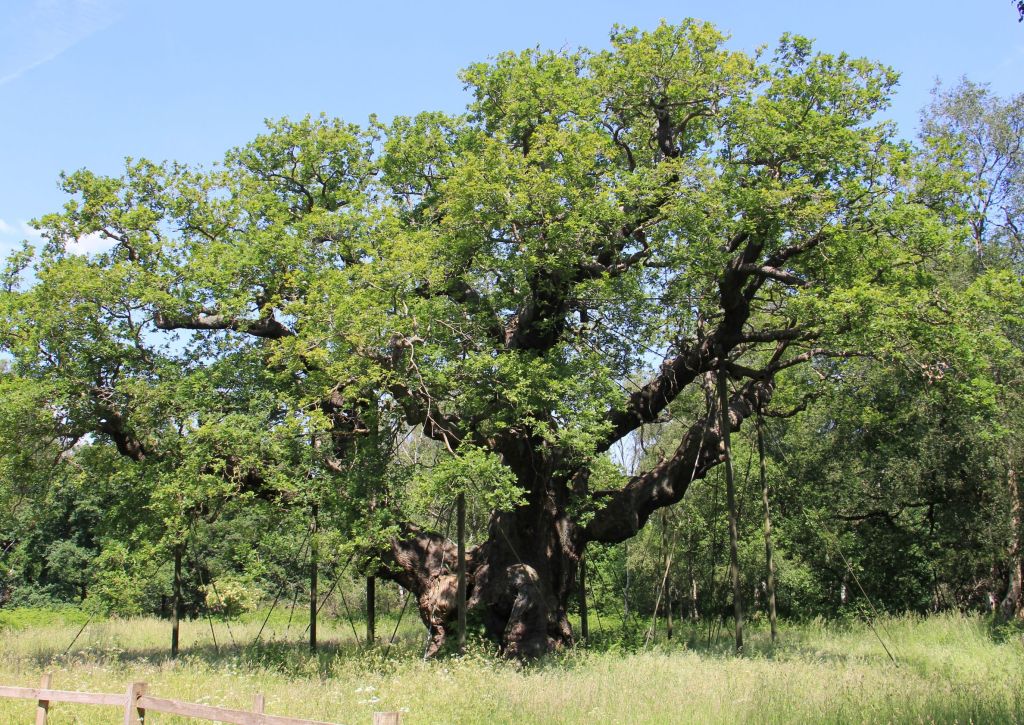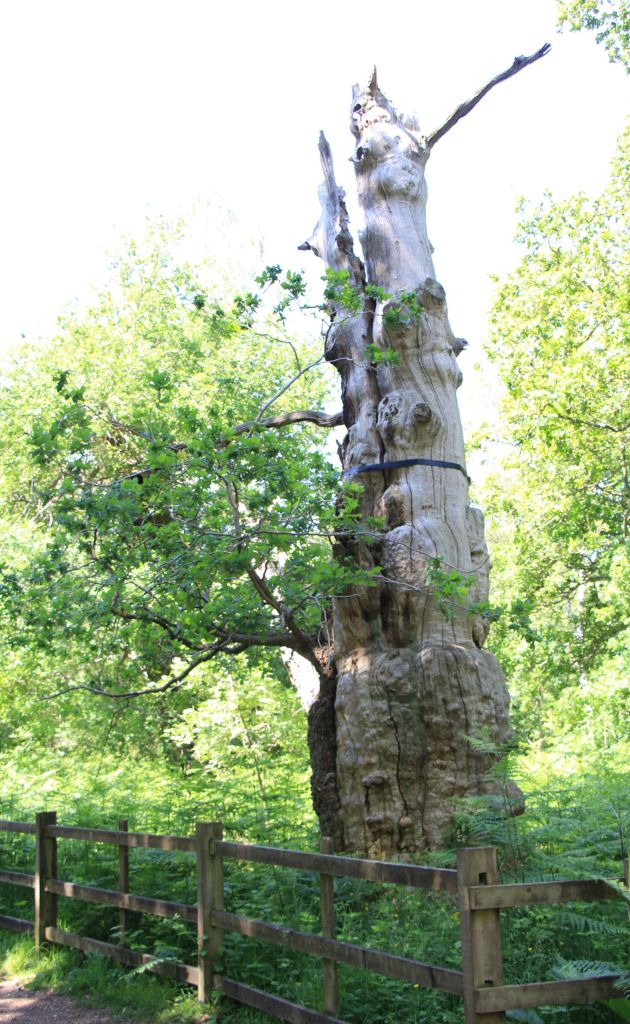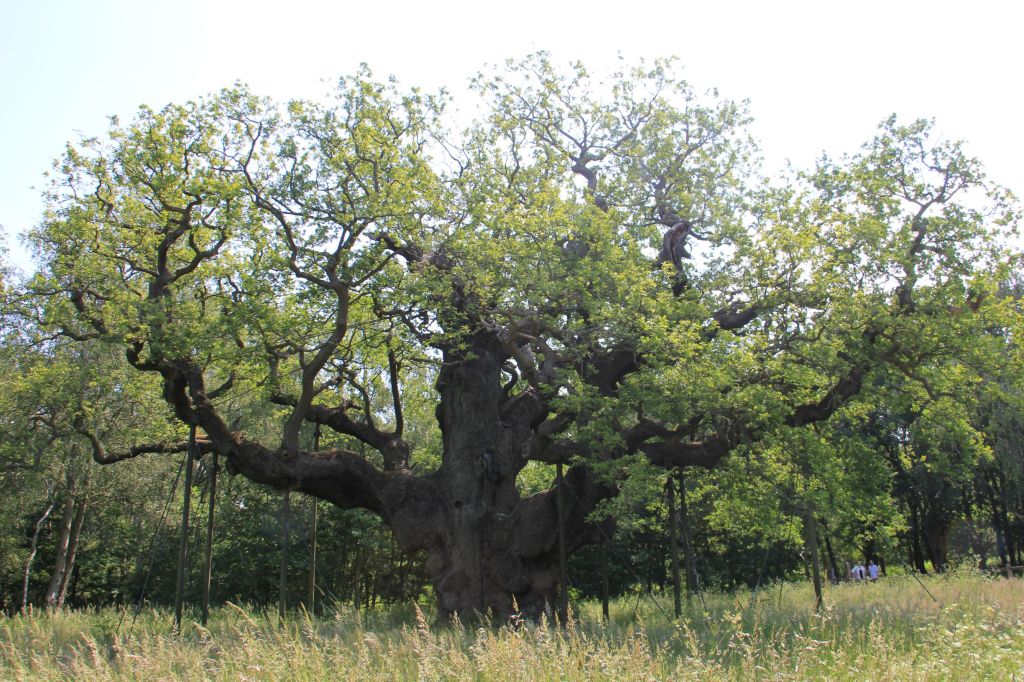Sherwood Forest once covered about a quarter of the historic county of Nottinghamshire, an area of around 7,800 hectares (19,000 acres). Today it’s a shadow of its former self, the Sherwood Forest National Nature Reserve weighing in at a measly 423 hectares (1,046 acres). And yet the magic lives on, courtesy of the legend of Robin Hood, hundreds of ancient oak trees and a few wandering nudists. Sounded like a fascinating place to visit, so we decided to give it a go.

Welcome to Sherwood, today just a fragment of a once vast forest in the English Midlands
In medieval times kings and their retinues of noble cronies hunted in Sherwood Forest, chasing down the buck and the boar and whatever else took their fancy. They lived the good life, with no regard for the pains and hardships of the poor. Ordinary people needed someone to fight their cause, and in Robin Hood they found just the man.
The Robin Hood story first emerged in the thirteenth century CE. Legend has it that Hood and his gang of outlaws hid out in Sherwood Forest, emerging from time to time to defend the rights of common folk, robbing from the rich and giving the proceeds to the poor, and all the while teaching the nobles a few much-needed lessons.

The Major Oak, the king of all Sherwood’s trees, is believed to be between 800 and 1,100 years old
As is inevitable with any oral tradition the legend of Robin Hood was embellished over the centuries, courtesy of the vivid imaginations of countless storytellers, poets and balladeers. Hard evidence of the famous folk hero’s actual existence is impossible to find, but that doesn’t really matter.
As a species, we humans call superheroes into existence because we need them to exist. The Robin Hood story emerged and flourished because our downtrodden ancestors desperately needed to believe that someone was looking out for them, and that their oppressors would be held to account.

Mrs P once hid in the Major Oak’s gnarled and fissured trunk. Sacrilege like that isn’t allowed these days!
Robin Hood is part of English national consciousness, a cultural icon. He’s been portrayed countless times on both the big and small screens, played by stars as diverse as Douglas Fairbanks, Errol Flynn, Kevin Costner and Kermit the Frog. The remakes and reinterpretations keep on coming, each generation retelling the story in its own way, and although there was no sign of him when we visited Sherwood Forest last month, Hood’s spirit lives on.
Also surviving in Sherwood Forest is a magnificent collection of ancient oak trees, many of them dating from the time when the Robin Hood legend first emerged. King of them all is the Major Oak, which is estimated at between 800 and 1,100 years old. Surprisingly the name doesn’t relate to its size and great age but instead references Major Heyman Rooke, who in 1790 wrote a book detailing his local oak trees.
When Mrs P was growing up (I’ll not say exactly when, but we’re talking several decades ago!) it was possible to walk right up to the Major Oak, to touch it and even to play hide-and-seek in and around it. Sadly those days are gone. Today admirers are kept at a respectful distance by picket fencing, thus preventing soil compaction which would damage the tree’s roots.

This magnificent Red Admiral brought a vibrant splash of colour to the greenwood
Since the 1970s the massive boughs of the Major Oak have been propped, another precautionary measure to help protect Sherwood Forest’s most venerable resident. Plainly the tree is in the twilight of its life, but looks in surprisingly good shape for its age. A bit like me, I suppose!
Some of the other trees are not faring so well. Rotten Roger has clearly seen better days, but a nearby notice (text reproduced below) wittily explains that decaying trees like this play a vital part in Sherwood’s ecosystem.

Rotten Roger has clearly seen better days
Oooh, I’m rotten to the core, just like my namesake. [Rotten Roger] was a nasty outlaw, a spy for the Sheriff, who was caught and locked inside my trunk by Robin Hood. Now I’m rotting from the inside out, but don’t be alarmed, it’s all part of my natural cycle. When a crack appears in an old tree like me, fungi creeps in and begins to rot away my heartwood. This rotting wood is great for beetles, flies and lots of other insects…not good for outlaws though. So although I may be a little heartless, I’m much loved by all these little creatures.
The leafy trails through the Sherwood Forest Nature Reserve are wonderfully atmospheric, not least for the symphony of birdsong that echoes all around, and the butterflies that bring extra colour to the greenwood. Birdsong and butterflies are not unexpected in a place like this, but nudists are. The official Sherwood Forest website warns that there is a long history of nudists – or naturists, as I believe they prefer to be called – wandering the forest trails.
Now I’m a broadminded soul and have no problem with my fellow citizens letting it all hang out wherever the fancy takes them, but common sense tells me this behaviour may be unwise. Thickets of briars and patches of stinging nettles hidden round every corner are an obvious hazard, to say nothing of columns of marching ants and the occasional random hedgehog lurking in the undergrowth. Nudism has its place, but I humbly submit that Sherwood Forest may not be it.

Its roots protected by fencing and its boughs supported by props, the Major Oak should still be here many years from now
When we visited the nudists were nowhere to be seen, or perhaps they were simply off somewhere nursing their injuries? Never mind, their presence or absence is of no consequence. Sherwood Forest is a majestic, tranquil haven where nature is protected and allowed to flourish, a place etched into our country’s folklore through the tales of Robin Hood and his merry band of outlaws. It’s well worth a visit if you’re ever in the area.
And finally, because it’s my ambition to share my taste in folk music with a wider audience, I invite you to listen to Barry Dransfield singing about Robin Hood and the Pedlar. The song, which can be traced back over 100 years, tells how our hero and his merry sidekick Little John encounter a pedlar, one Gamble Gold by name, and plot to rob him. A fight breaks out, but then it’s revealed that Mr Gold is in fact Robin Hood’s cousin. At this point they all adjourn to the nearest pub to sup some ale and get even merrier. Fanciful stuff, a bit cheesy I suppose. But nevertheless Robin Hood and the Pedlar is a lot of fun, and Dransfield puts in some lively guitar work for us to admire. Enjoy!
Postscript: If ancient trees are your thing you may be interested in this post about the Old Man of Calke, another majestic oak believed to be around 1,200 years old.
Really interesting post that weaves the past with the present. I thought that your observation about super heroes was spot on. And that Major Oak is magnificent! Sorry kids can’t play hide and seek there the way your wife once did. Finally, enjoyed the song.
LikeLiked by 2 people
Thank you, Laurie 🙂. The superheroes thing is very interesting. Although it’s tempting to think of them as a modern phenomenon, I suspect the need for them is hardwired into our DNA. We all need a Robin Hood, or his Marvel equivalent, at some point in our lives!
LikeLiked by 2 people
Absolutely!
LikeLiked by 1 person
We were there in 1977 or maybe ’78. A quiet forest that belied its place in history. We camped there or somewhere near overnight I think … Hard to remember now. Great to get an update.
LikeLiked by 2 people
What I mean by ‘belie’ is its quietness and placid nature seemed strange, as it has so much history – but as much of it is fable, maybe that was why it appeared so innocent. I remember the oak, but can’t remember if we got close or not at that time.
LikeLiked by 1 person
Although, as you say, the Hood story is mostly fable, the fact that it’s rooted so firmly in Sherwood Forest suggests to me that in the Middle Ages this place had a special character that caused it to be approached warily, and also with a degree of reverence. It’s not easy to feel that way today, when the forest paths are crowded with people playing with their mobile phones, and kids filling their faces with ice cream and cola. Is nothing sacred? 🙂
LikeLike
Wonderful post. So many legends in memory. I must add that my favorite Sheriff, by far, was the portrayal by Alan Rickman–unforgettable.
LikeLiked by 1 person
Thank you, Gary, unsolicited praise always welcome 🙂. I agree totally about Rickman’s performance, which for me is the highlight of that movie. Quirky, funny and – as you say – unforgettable!
LikeLiked by 1 person
This felt magical.
LikeLiked by 2 people
Sherwood Forest is a magical place, very special indeed!
LikeLike
Nice post! I’ve watched and enjoyed at least two Robin Hood movies (Errol Flynn, and Men in Tights). Very English! Rotten Roger sounds really cute.
LikeLiked by 2 people
Thank you! Good to know you’ve watched and enjoyed those movies: the Robin Hood story provides plenty of opportunities for lively, “feel-good” films.
LikeLiked by 2 people
All of us like a good Robin Hood Story from time to time to appeal to our sense of justice, I guess. As you point out, each generation adapts the story to its own particular needs.
I’m also glad to hear that you are in surprisingly good shape for your age! 🙂
LikeLiked by 3 people
I have a confession to make: I made the comment about my being in surprisingly good shape for my age for literary effect, because I thought it to be funny rather than because I knew it to be true! In reality, my fitness level in my mid-60s is better summed up by the title of the ground-breaking novel written in 1958 by the Nigerian writer Chinua Achebe: “Things Fall Apart”. 🙁 Ouch!
LikeLiked by 2 people
There is always superglue! 🙂
LikeLiked by 2 people
I’ll order a gallon immediately! 🙂🙂🙂
LikeLiked by 2 people
Fascinating and insightful, Platypus Man! I do love a forest and this one has a deep and meaningful significance.
LikeLiked by 3 people
Thank you, Leah 🙂 Yes, forests can connect us with a simpler, more spiritual world, the world we have lost.
LikeLiked by 1 person